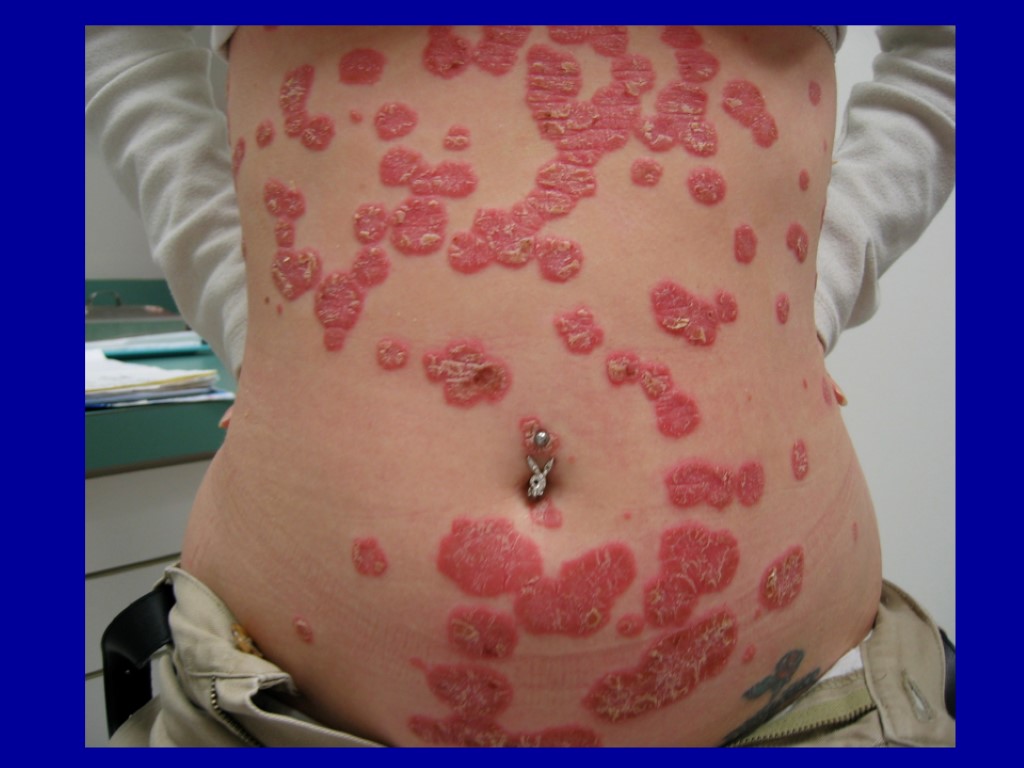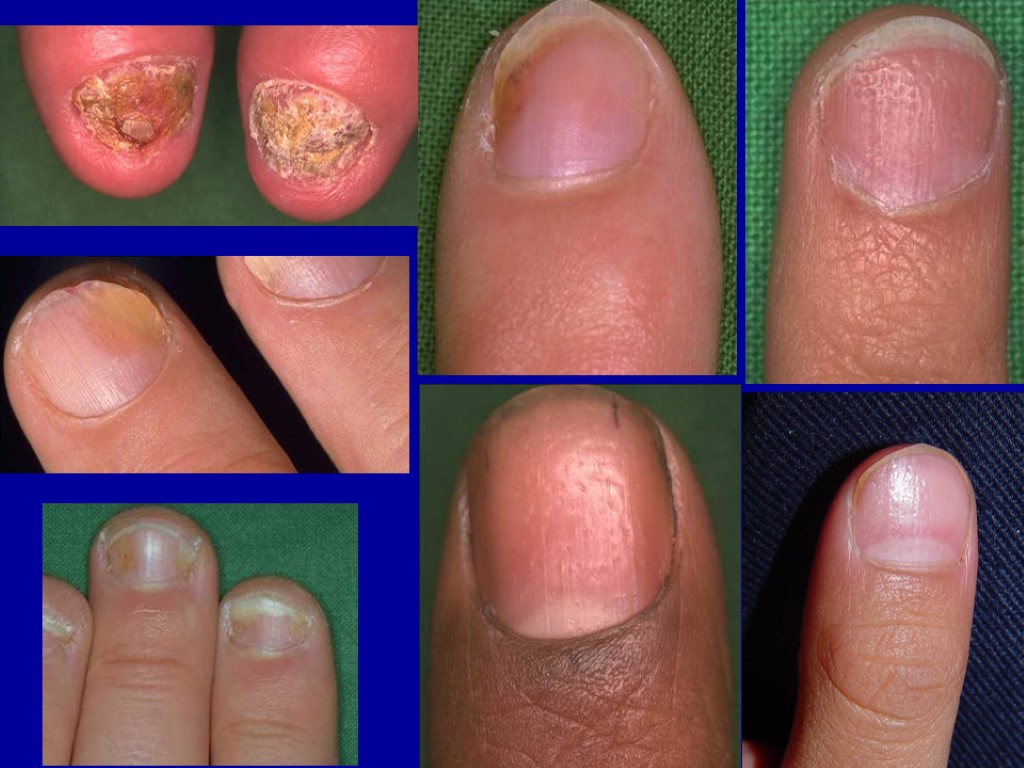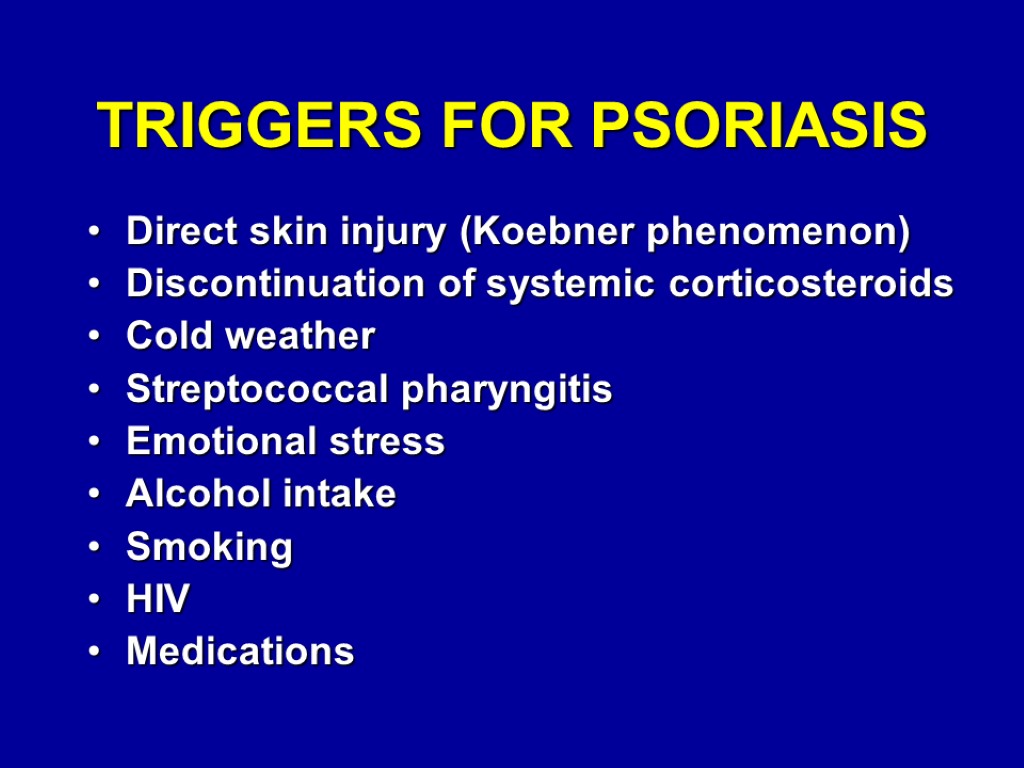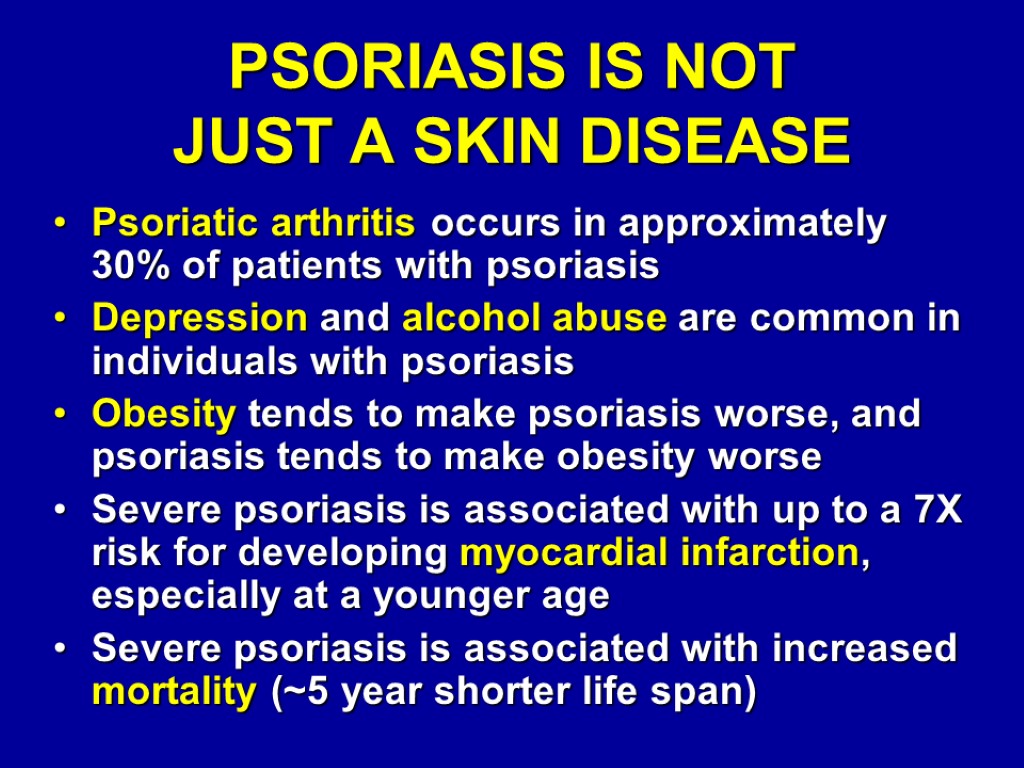PSORIASIS Andrew Blauvelt, M. D. Professor, Dept. of


PSORIASIS Andrew Blauvelt, M.D. Professor, Dept. of Dermatology and Dept. of Molecular Microbiology & Immunology Oregon Health & Science University Chief, Dermatology Service Veteran’s Affairs Medical Center Portland, Oregon

CONFLICTS OF INTEREST • Centocor: scientific advisor, investigator for clinical studies, received lab research funds • Abbott: scientific advisor, investigator for clinical studies • Lilly: scientific advisor, investigator for clinical studies • Amgen: scientific advisor • Novartis: scientific advisor

WHAT IS PSORIASIS? A common, life-long, genetic, autoimmune skin disease Characterized by well circumscribed areas of thick, red, scaly skin From the Greek “psoros” meaning “rough, scabby” Term first used (along with “lepra”) by Hippocrates (460-377 B.C.) in Corpus Hippocraticum von Hebra first to distinguish psoriasis from leprosy in 1841

Affected skin is painful, itchy, often bleeds, and is debilitating when involving the face, genitals, palms, or soles Under the microscope, affected skin is thickened, has increased blood vessels, and contains numerous white blood cells

CLASSIC ANATOMIC LOCATIONS FOR PSORIASIS Scalp (80%) Elbows (78%) Legs (74%) Knees (57%) Nails (10-55%) Gluteal cleft Palms/soles (12%)

CLINICAL VARIANTS Chronic plaque psoriasis Guttate psoriasis Erythrodermic psoriasis Generalized pustular psoriasis (von Zumbusch) Localized pustular psoriasis Palmaris et plantaris Acrodermatitis continua Inverse psoriasis








PSORIATIC NAIL CHANGES Onycholysis “Oil drops” “Salmon patches” Pitting Subungual debris Onychodystrophy Splinter hemorrhages


TRIGGERS FOR PSORIASIS Direct skin injury (Koebner phenomenon) Discontinuation of systemic corticosteroids Cold weather Streptococcal pharyngitis Emotional stress Alcohol intake Smoking HIV Medications

DRUGS THAT CAN EXACERBATE PSORIASIS *Beta blockers *Lithium *IFN-alpha Antimalarials ACE inhibitors *Rebound with withdraw of prednisone and cyclosporine

TYPICAL HISTORY FOR PSORIASIS Average age of onset is 28 years, although disease can begin in infants or in the elderly Bimodal peaks: late teens (type I psoriasis, family history) and early 40’s (type II psoriasis, no family history) Once it has begun, it persists Many patients have family members affected, although many others do not At least 10 genes identified: HLA-Cw6, IL-23 p19, IL-12/IL-23 p40, IL-23R

PSORIASIS IS NOT JUST A SKIN DISEASE Psoriatic arthritis occurs in approximately 30% of patients with psoriasis Depression and alcohol abuse are common in individuals with psoriasis Obesity tends to make psoriasis worse, and psoriasis tends to make obesity worse Severe psoriasis is associated with up to a 7X risk for developing myocardial infarction, especially at a younger age Severe psoriasis is associated with increased mortality (~5 year shorter life span)

PSORIASIS SIGNIFICANTLY IMPAIRS QUALITY OF LIFE Fear of contagion from others (“modern day lepers”) Low self esteem (“something’s wrong with me”) Need to cover up (“I don’t want anyone to see”) Sexual impairment Hand/foot lesions that interfere with activities of daily living Itching that interferes with sleep and activities of daily living Arthritis that impairs activities of daily living


PSORIASIS AS A SYSTEMIC DISEASE: CHANGING PRACTICE Use systemic therapy more (do TNF- blockers have beneficial effects on metabolic syndrome/cardiovascular risk/mortality?) More monitoring: baseline blood pressure, fasting glucose/lipids More conversations on smoking and alcohol cessation More referrals to internal medicine, nutrition, cardiology, rheumatology, psychiatry, gastric bypass surgery

SEVERITY OF PSORIASIS (older view) Mild disease: <5% of body surface covered (65% of patients with this type) Moderate disease: 5-10% of body surface area covered (25% of patients with this type) Severe disease: >10% of body surface area covered or palm/sole involvement (10% of patients with this type)

SEVERITY OF PSORIASIS (contemporary view) “Mild,” “moderate,” and “severe” replaced with: Candidates for localized therapy Candidates for systemic therapy Candidates for systemic therapy may have one or more of the following features: BSA greater than 5% Involvement of vulnerable areas of the body, including palms, soles, face, scalp, and genitals Significant impact on quality of life Failure of localized therapy Concomitant psoriatic arthritis

TOPICAL THERAPIES FOR PSORIASIS Corticosteroids: mid-high potency for most areas, low potency for face and intertriginous areas Calcipotriene (Dovonex®): works best in combination with topical corticosteroids Tazorotene (Tazorac®): works best in combination with topical corticosteroids Tacrolimus (Protopic®): for face and intertriginous areas Ointments, creams, gels, foams, sprays, shampoos, and medicated tape all available

OLDER SYSTEMIC THERAPIES FOR PSORIASIS Phototherapy: UVB, narrow-band UVB, PUVA, Excimer laser Methotrexate Acitretin (Soriatane®) Cyclosporine

BIOLOGIC TREAMENTS FOR PSORIASIS/PSORIATIC ARTHRITIS Alefacept (Amevive®): LFA3-tip, targets CD2+ T cells Etanercept (Enbrel®): soluble TNF- receptor Adalimumab (Humira®): human anti-TNF- mAb Infliximab (Remicade®): chimeric anti-TNF- mAb Golimumab (Simponi®): human anti-TNF- mAb Ustekinumab (Stelara®): human anti-IL-12/IL-23 mAb

APPROXIMATE PASI 75 RESPONSES TO BIOLOGICS AT WEEK 12 • Alefacept (Amevive®): 20-25% Etanercept (Enbrel®): 40-50% Adalimumab (Humira®): 60-70% Infliximab (Remicade®): 75-80% Golimumab (Simponi®): 50% Ustekinumab (Stelara®): 70% (80% at week 24)

MAJOR POTENTIAL SIDE EFFECTS OF TNF- BLOCKING AGENTS • Infection (3x), including hepatitis B and TB reactivation • Lymphoma (rare, 3x in RA) • Multiple sclerosis (rare) • Worsening of CHF • Transaminitis (infliximab > others) • Cytopenias (rare)

MONITORING BEFORE AND DURING METHOTREXATE AND TNF- BLOCKER USE Baseline: PPD, hepatitis profile, CBC with diff, chemistry panel Every 3 months: clinically monitor progress and perform ROS for tolerability, infections, cancers (lymphoma), MS; CBC with diff and chemistry panel for methotrexate Every 6 months: CBC with diff and chemistry panel for TNF- blockers Every year: PPD for TNF- blockers

PRACTICAL FACTORS INVOLVED IN CHOOSING SYSTEMIC THERAPY Efficacy (PASI 75) Potential side effects of drug Type of psoriasis Impact on quality of life/patient needs Presence/absence of psoriatic arthritis Concomitant morbidities Ease of administration Insurance coverage/out of pocket costs FDA approved for indication

BLAUVELT PREFERENCES IN CERTAIN SETTINGS Moderate-to-severe psoriasis: methotrexate first, then TNF- blocker (NB-UVB if practical) Psoriatic arthritis with any amount of skin disease: methotrexate first, then adalimumab Moderate-to-severe skin disease and concomitant alcohol abuse/hepatitis C: etanercept, adalimumab Moderate-to-severe skin disease and concomitant obesity/diabetes/metabolic syndrome: adalimumab Palmoplantar disease: methotrexate, acitretin Erythrodermic psoriasis: infliximab Pustular psoriasis: infliximab, acitretin HIV psoriatic: acitretin, NB-UVB if practical

NATIONAL PSORIASIS FOUNDATION (NPF) Established as patient support group in Portland, OR in 1968 The best information about psoriasis, psoriatic arthritis, and treatments Psoriasis Advance magazine, 6 issues per year Support and encouragement through an online community of thousands Directory of doctors Assistance on insurance issues Driving research for better treatments and control Encourage all of your patients to join

THE END
19_blauvelt_psoriasis_lecture.ppt
- Количество слайдов: 34

